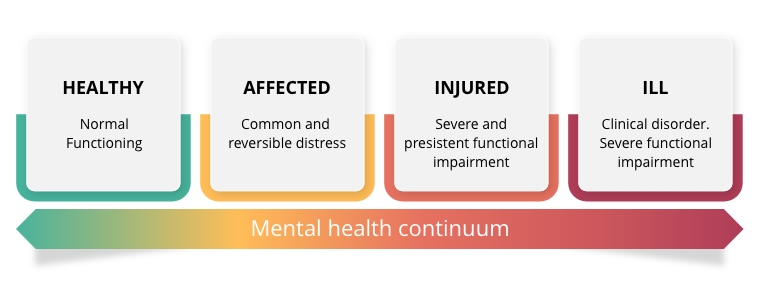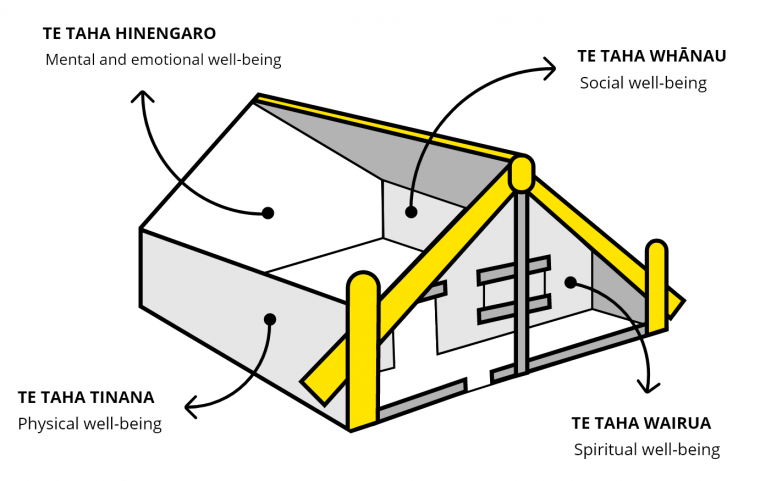What is mental health?
He aha te hauora hinengaro?
Mental health is about how we think, feel and act as we deal with life’s ups and downs. It also helps determine how we handle stress, relate to others, and make choices.
Mental health is part of Te Whare Tapa Whā – the Four Cornerstones of Health
Taking care of your mental health
Being mentally healthy is not necessarily about being free from problems. Mental health is more about identifying problematic (thought and behavioural) patterns when they arise, and learning to replace them with purposeful positive alternative ones.
Just as we would take care of a sore ankle perhaps by resting and not putting additional strain on it for a while, we can take care of our mental health in the same way. By not overloading ourselves, and by practicing good mental health maintenance activities, we can get back on track.
For some people, poor mental health can turn into mental illness
Everyone feels worried, anxious, sad or stressed at various times in their lives and this is perfectly normal. With a mental illness, these thoughts and feelings do not go away and are severe enough to interfere with daily life. It can make it hard to meet and keep friends or other important relationships, hold a job, or enjoy your life. Mental illness is about impaired functioning and a general loss of quality of life.
The Te Whare Tapa Wha (Professor Mason Durie) model of health reinforces the importance of nurturing all four cornerstones of our health (Hinengaro, Tinana, Wairau and Whānau) for overall health and wellbeing. There is a strong relationship between physical and mental health.
Our whānau, social support, family wellbeing and how well we are able to live life in a way that feels meaningful and aligned with our values all contribute to overall health and wellbeing. It is important we nurture all four areas.
Your mental health is important to the NZDF
The Mental Health Foundation of New Zealand reports that just under 50% of Kiwis will experience mental illness or addiction at some point in their lives with one in five people affected within any one year.
Data from Defence Health suggests the rates are similar for our people. However, we probably don’t have the full picture. For example, we don’t know who accesses mental health support outside the military system, and we don’t know how many people choose not (or don’t know how) to access help at all.
Depression, anxiety and alcohol issues are the more common issues. Post Traumatic Stress Disorder (PTSD) or other operational stress injuries are less common.
This website contains information on your mental health and useful tools to help maintain mental health and overall wellbeing.
The mental health continuum
Mental health exists on a continuum. It can move up and down the continuum depending on different circumstances - and can get better or worse. The good news is that for many mental health concerns, support and treatment are available to help.

The NZDF mental health continuum shows how levels of mental health are reflected in:
-
What we do (behaviours)
-
How we feel (emotions)
-
How we think (cognitions)
-
How we feel in our body (physical)
Common signs are reflected along the continuum, so you can see how your problems increase and your functioning decreases, as you move towards the right along the continuum. They are grouped into six themes:
-
Mood
-
Attitude
-
Sleep
-
Physical Health
-
Activity
-
Habits
The continuum goes from healthy, adaptive coping (green), through mild and reversible distress or functional impairment (yellow), to more severe, persistent injury or impairment (orange), through to clinical illnesses and disorders requiring more concentrated medical care (red).
What can you learn from the mental health continuum?
It shows that mental health is not all or nothing – there is a lot of ground in between being healthy and being ill. ANYONE can move along the scale to being injured and ill depending on the circumstances – no one is immune to becoming ill.
The important things to note are:
-
you can go from being healthy and move along the scale until you are eventually ill
-
AND you can go from being ill through to being healthy – this is helped by being resilient
Where we sit on the continuum at any point in time will shift depending on life experiences, the cumulative level of stress, levels of resilience (natural and learned) and levels of support.
You should be aware of where you are on the continuum, and the signs that indicate you may need to use additional coping strategies or seek help to maintain your performance and mental health.
By using the strategies below, you can learn to minimise the impact life experiences can have on mental health, and strive to maintain positive mental health and performance over time.
You’ll also know when it’s time to get help.


